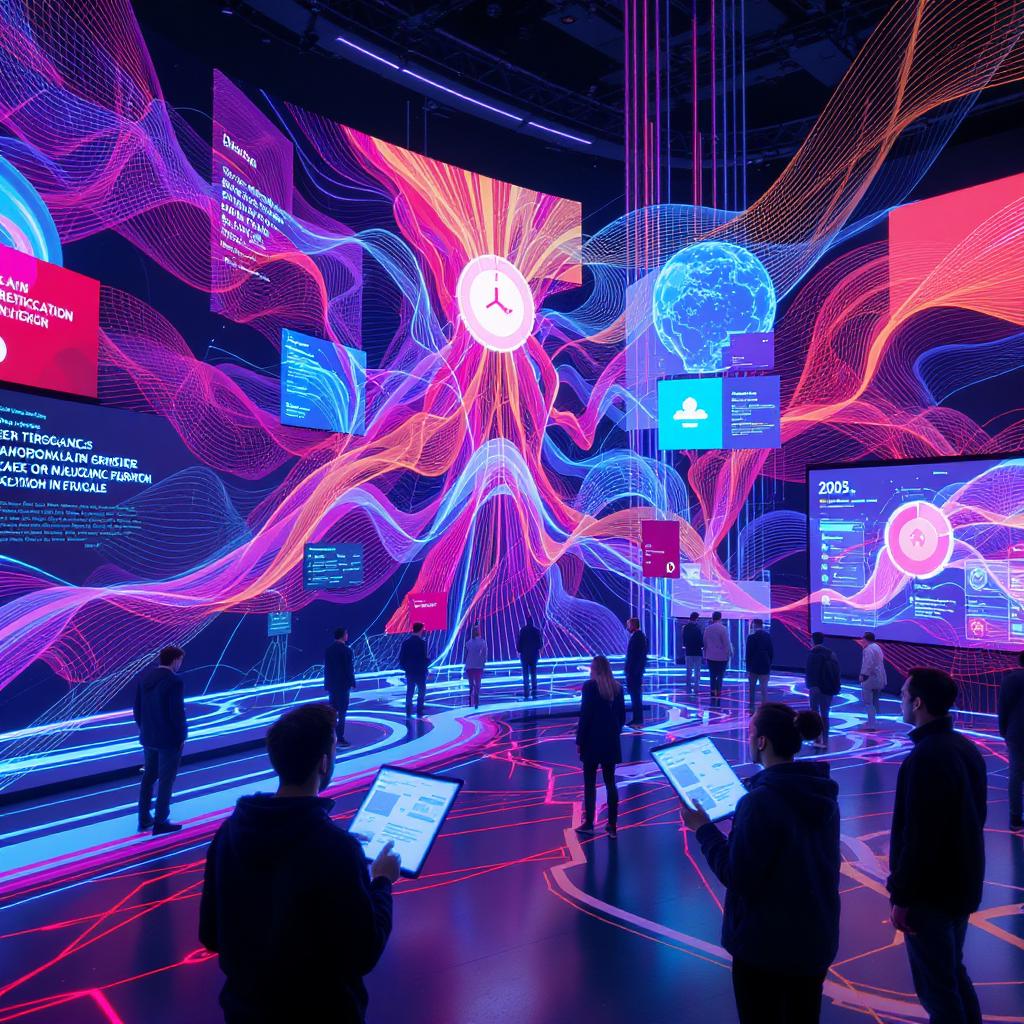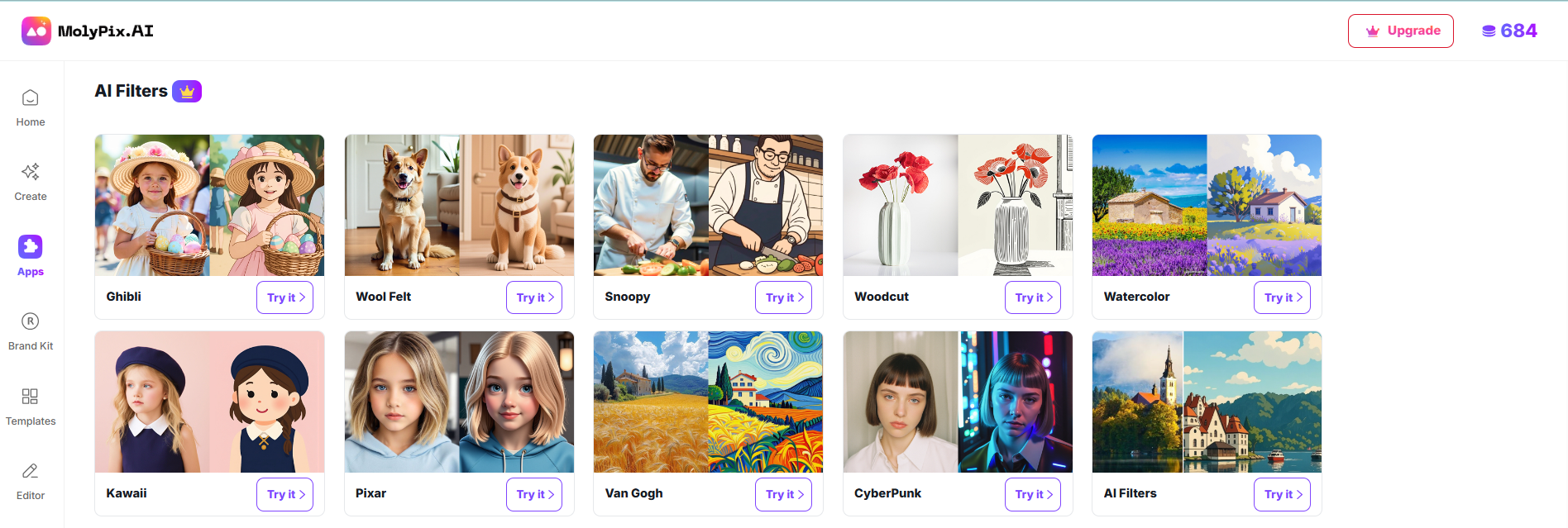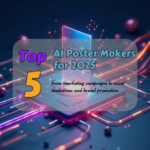The Revolutionary Impact of AI on Graphic Design Trends 2025

Introduction: The Dawn of a New Creative Era
The creative landscape is undergoing a profound transformation as we navigate through 2025, with artificial intelligence fundamentally reshaping graphic design trends across every medium and platform. What once required hours of specialized training and technical expertise is now being reimagined through the collaborative potential between human creativity and AI capabilities. For designers, marketers, and businesses alike, understanding these emerging graphic design trends 2025 isn’t just advantageous—it’s essential for staying relevant in an increasingly competitive visual marketplace.
The rapid evolution of AI design tools has created both exciting opportunities and legitimate concerns. Many creatives worry about job security, while businesses struggle to keep pace with escalating visual standards. Meanwhile, the democratization of design has made it possible for almost anyone to create professional-looking graphics, raising questions about the future value of design expertise.
As we explore how AI is revolutionizing graphic design in 2025, we’ll examine the technological developments driving these changes, the most influential trends emerging from this transformation, and how tools like MolyPix.AI are positioning themselves within this evolving landscape. Whether you’re a seasoned designer, someone exploring graphic design jobs, or simply curious about the future of visual communication, this comprehensive guide will provide valuable insights into navigating the AI-driven design revolution.
The Evolution of AI in Graphic Design: How We Got to 2025
From Basic Automation to Creative Partnership
The integration of AI into graphic design didn’t happen overnight. The journey began with simple automation tools that handled repetitive tasks like resizing images or applying basic filters. Early applications primarily focused on efficiency rather than creativity, saving time but offering limited creative value.
As we progressed through the early 2020s, more sophisticated AI applications emerged:
- Neural networks capable of generating custom typography
- Advanced color palette generators grounded in color theory
- Automated layout systems that applied fundamental design principles
- Image generation tools that could create original visuals from text prompts
Each of these developments represented significant steps toward AI systems that could understand design intent rather than simply executing predefined commands.
Key Milestones on the Path to 2025
Several technological breakthroughs paved the way for the graphic design trends 2025 we’re now experiencing:
- 2021-2022: The emergence of text-to-image generators that could create surprisingly coherent visuals from written descriptions
- 2023: Integration of design-specific AI models trained on professionally curated design collections
- 2024: Development of context-aware design systems that could adapt to different platforms and cultural preferences
- 2025: The rise of truly collaborative AI design assistants that learn from individual designer preferences
These advancements have collectively transformed AI from a simple productivity tool into a genuine creative partner, fundamentally changing how designers approach their work and who has access to design capabilities.
5 Dominant Graphic Design Trends 2025 Powered by AI
- Hyper-Personalized Adaptive Design
One of the most significant graphic design trends 2025 has introduced is the shift from static, one-size-fits-all designs to dynamic visuals that adapt based on audience, context, and individual user data.
AI-powered design tools can now analyze vast datasets to customize visual elements in real-time, including:
- Color schemes that adjust based on cultural preferences or brand affinity
- Typography that automatically optimizes for readability across devices
- Imagery that resonates with specific demographic segments
- Layouts that adapt to different platforms without losing design integrity
This level of personalization was previously impossible at scale. Today, brands can deliver tailored visual experiences that connect more meaningfully with diverse audiences—all while maintaining cohesive brand identity.
The potential applications span various industries:
- E-commerce: Product imagery that emphasizes features most relevant to each shopper
- Marketing: Campaign materials that automatically adjust to regional preferences
- Publishing: Content layouts that adapt based on reading behavior
- Education: Learning materials that present information in visually optimized ways for different learning styles
- Minimalism Enhanced by AI-Generated Complexity
The tension between simplicity and visual interest has always challenged designers. In 2025, we’re seeing a fascinating convergence where clean, minimalist frameworks serve as the foundation for AI-generated complex elements.
This trend represents the perfect balance between clarity and visual richness. Designers are using AI to create:
- Intricate patterns and textures that would be prohibitively time-consuming to produce manually
- Complex illustrations generated from simple text prompts
- Detailed background elements that add depth without overwhelming the primary message
The appeal of this approach lies in its versatility. The minimalist foundation ensures clarity of communication and brand recognition, while the AI-generated elements provide unique visual interest that captures attention.
For those pursuing graphic design jobs in 2025, developing expertise in directing AI to create these complex elements while maintaining minimalist principles is becoming an increasingly valuable skill.
- Dynamic Interactive Content Generation
Static imagery continues to give way to motion and interactivity in 2025’s graphic design trends. AI’s role in creating sophisticated motion graphics and interactive visuals has expanded dramatically, making dynamic content accessible even to those without animation expertise.
Today’s AI design tools can:
- Transform static designs into engaging motion pieces through intelligent animation
- Generate responsive visual elements that adapt to user interactions
- Create personalized animated sequences based on data inputs
- Convert simple illustrations into complex motion graphics
This trend is particularly evident in digital advertising, social media content, and website design, where motion and interactivity significantly increase engagement metrics. The ability to quickly generate high-quality motion graphics has become a competitive advantage for brands seeking to capture attention in crowded digital spaces.
- AI-Powered Rapid Prototyping and Iteration
The design process itself has been transformed by AI-enabled rapid prototyping. What once took days of exploration now happens in minutes, with AI tools generating multiple design variations based on initial concepts.
For professionals in graphic design jobs, this acceleration means:
- More time for strategic thinking and creative direction
- The ability to explore diverse design approaches simultaneously
- Faster iteration cycles based on feedback
- Higher quality final deliverables through more thorough exploration
This trend has particular significance for agencies and in-house design teams facing tight deadlines. The ability to quickly visualize multiple directions allows for more informed decision-making and ultimately more refined final products.
- Democratization of Design Through Accessible AI Tools
Perhaps the most far-reaching of all graphic design trends 2025 has introduced is the true democratization of design capabilities. AI-powered tools, including many graphic design apps free of charge at basic tiers, have encoded design principles into accessible interfaces that empower non-designers to create visually compelling materials.
This accessibility has significant implications:
- Small businesses can establish professional visual identities without substantial investment
- Content creators can produce visually consistent materials across platforms
- Marketing teams can generate campaign assets more efficiently
- Entrepreneurs can launch with polished visual presentations
Importantly, this trend doesn’t eliminate the need for professional designers. Rather, it elevates the baseline quality of visual communication while allowing design professionals to focus on higher-level creative direction, strategy, and the nuanced aspects of design that AI still struggles to master.
The Tangible Benefits of AI in Graphic Design
Time Efficiency: From Days to Minutes
The most immediate benefit of incorporating AI into graphic design workflows is dramatic time savings. Tasks that once consumed hours—like image editing, layout exploration, or creating variations—can now be completed in minutes.
For professionals in graphic design jobs, this efficiency translates to:
- Higher productivity without increasing work hours
- Reduced burnout from repetitive tasks
- More focus on creative problem-solving rather than technical execution
- Greater capacity to meet tight deadlines
A designer using AI tools can potentially accomplish in one day what might have previously taken an entire week, fundamentally changing project timelines and client expectations.
Enhanced Creativity Through Collaboration with AI
Contrary to fears that AI might limit creativity, 2025’s design landscape demonstrates that AI tools often enhance creative thinking by suggesting unexpected combinations, variations, and approaches that human designers might not initially consider.
AI design assistants function as collaborative partners that:
- Overcome creative blocks by generating starting points
- Suggest novel combinations that expand creative possibilities
- Visualize concepts quickly to validate or redirect creative thinking
- Expose designers to stylistic approaches outside their comfort zone
This collaborative relationship between human and AI can lead to more innovative design solutions that neither would likely achieve independently.
Cost Reduction: Professional Quality on Any Budget
The economic impact of AI-driven graphic design trends 2025 cannot be overstated. With the rise of AI design tools, including various graphic design apps free at basic tiers, professional-quality design has become accessible at almost any budget level.
This democratization has:
- Reduced barriers to entry for startups and small businesses
- Allowed for more frequent design refreshes without proportional cost increases
- Enabled smaller teams to produce more content with limited resources
- Created opportunities for businesses to allocate design budgets more strategically
For businesses that previously couldn’t afford professional design services, AI tools represent an opportunity to compete visually with much larger organizations.
Accessibility: Design for All
Perhaps most importantly, AI has made quality design accessible to creators regardless of formal training, natural artistic ability, or financial resources. This accessibility has raised the overall standard of visual communication across digital and print media.
The implications are particularly significant for:
- Educators creating learning materials
- Non-profits with limited resources
- Small businesses and solo entrepreneurs
- Content creators across platforms
As design tools become more intuitive and AI assistance more sophisticated, the technical barriers to creating professional-looking materials continue to diminish.
MolyPix.AI: A Potential Player in the AI Design Landscape

Current Positioning in the Market
MolyPix.AI has emerged as a significant contender in the AI-powered design space, embodying many of the graphic design trends 2025 we’ve discussed. Unlike earlier design tools that simply automated basic tasks, MolyPix.AI represents the new generation of AI design platforms that function as true creative partners.
What sets MolyPix.AI apart in this competitive landscape is its comprehensive approach to AI-assisted design. The platform combines several cutting-edge capabilities that align perfectly with the evolving needs of both professional designers and creative novices:
- One-Prompt Design Generation: MolyPix.AI excels at transforming simple text descriptions into complete, professional designs. Users can describe their vision in natural language (e.g., “Create a minimalist tech conference poster with blue and white color scheme”), and the AI generates multiple design options based on that single prompt—embodying the rapid prototyping trend that’s reshaping design workflows in 2025.
- Editable Designs: Rather than producing flat, inflexible outputs, MolyPix.AI creates fully editable designs, all within the platform itself. This allows users to edit a particular section of the generated designs without having to start over, saving time while preserving the crucial balance between AI efficiency and human creative control that professionals require.
- Diverse Template Library: The platform offers an extensive collection of templates spanning numerous categories—from event posters and social media content to business materials and invitations. These templates serve as intelligent starting points that the AI can customize based on specific requirements, significantly accelerating the design process.
- Integrated GPT-4o Functionality: By incorporating advanced language model technology, MolyPix.AI can interpret complex design briefs and generate appropriate visuals. This “Design GPT” capability represents a significant advancement in how AI understands and executes creative direction.
- Specialized AI Apps: The platform includes a suite of AI-powered editing tools that align with the efficiency trends dominating graphic design trends 2025, including:
- Magic Edit for intelligent modification of design elements
- Magic Erase for removing unwanted elements from images
- Background removal tools that automatically extract subjects
- AI Style Filters: Reflecting the trend toward AI-generated complexity, MolyPix.AI offers artistic filters that can transform designs into various styles including Studio Ghibli-inspired aesthetics, Pixar-like renderings, watercolor effects, and numerous other artistic approaches—all while maintaining design integrity.

These capabilities collectively address the core needs driving graphic design trends 2025: personalization, efficiency, accessibility, and the balance between automation and creative control.
Practical Applications in Today’s Design Landscape
The comprehensive feature set of MolyPix.AI enables practical applications across various design contexts:
Brand Identity Development
For startups and established businesses alike, MolyPix.AI streamlines the creation of consistent visual systems. The ability to maintain brand elements using the Brand Kit function while quickly generating variations for different touchpoints makes comprehensive branding accessible even without extensive design resources.
Content Marketing at Scale
Content teams can leverage MolyPix.AI to produce the high volume of visuals required for effective digital marketing. The platform’s efficiency allows for maintaining visual quality even with aggressive content calendars—particularly valuable as visual content continues to dominate engagement metrics.
Accessible Design for Non-Designers
Perhaps most significantly, MolyPix.AI empowers those without formal design training to create professional-quality visuals. This democratization effect is particularly valuable for:
- Small business owners managing their own marketing
- Content creators building personal brands
- Marketing teams without dedicated design resources
The platform effectively bridges the gap between graphic design apps free of technical barriers and professional-grade design tools, making sophisticated visual communication accessible across skill levels.
How MolyPix.AI Addresses Common Design Challenges
MolyPix.AI’s approach to AI-assisted design directly addresses several pain points that have traditionally complicated the design process:
- Time Constraints: By generating complete designs from simple prompts, the platform dramatically reduces the time required to move from concept to execution—turning what might have been days of work into minutes.
- Design Consistency: The ability to save brand elements and style preferences helps maintain visual consistency across projects, solving a common challenge for organizations producing high volumes of content.
- Creative Blocks: When designers face creative blocks, MolyPix.AI’s suggestion capabilities can provide fresh perspectives and unexpected approaches that spark new creative directions.
- Technical Limitations: For users without extensive technical skills, the intuitive interface and AI assistance remove design barriers that would typically require days or even weeks to overcome.
As the design landscape continues to evolve, platforms like MolyPix.AI represent the direction in which AI-assisted design is moving—toward more collaborative, accessible, and efficient creative tools that expand what’s possible while maintaining the essential human element of design decision-making.
Navigating Challenges and Ethical Considerations
Finding Balance: Human Creativity and AI Assistance
Despite the benefits, the AI design revolution brings important challenges. The risk of over-reliance on AI is real—when designers become too dependent on algorithmic suggestions, a homogenization of style can occur, potentially diluting the human touch that makes design emotionally resonant.
The most successful designers in 2025:
- Use AI as a starting point rather than the final answer
- Maintain their unique aesthetic perspective while leveraging AI capabilities
- Know when to override AI suggestions based on brand strategy and context
- Continuously develop their own design thinking skills
Finding this balance represents one of the most significant challenges—and opportunities—for designers navigating the AI-enhanced landscape.
Evolving Copyright and Ownership Questions
As AI systems train on existing works and generate new content, copyright and ownership issues continue to evolve. Questions about attribution, originality, and fair use remain complex in 2025, particularly when AI systems combine elements from multiple sources.
Key concerns include:
- Who owns the rights to AI-generated designs?
- How should training data be ethically sourced and credited?
- What constitutes originality in an AI-assisted creative process?
- How should derivative works be recognized and compensated?
For those in graphic design jobs, staying informed about legal developments in this area is becoming an essential professional responsibility, as the legal landscape continues to develop in response to technological capabilities.
Quality Control in an Automated World
While AI can generate countless options quickly, maintaining brand consistency and ensuring appropriate messaging requires human oversight. The balance between automation and maintaining brand identity remains delicate.
Effective quality control strategies include:
- Establishing clear brand guidelines for AI-assisted design
- Implementing human review processes for AI-generated content
- Providing specific, detailed prompts to guide AI outputs
- Regularly auditing design outputs for consistency and quality
Organizations that successfully implement AI design tools typically develop robust processes for maintaining quality standards while benefiting from AI efficiency.
The Future of Graphic Design: Beyond 2025
Emerging Technologies on the Horizon
Looking beyond current graphic design trends 2025, we can anticipate even deeper integration of AI into the creative process. Emerging technologies suggest we’ll soon see:
- AI systems that understand abstract creative direction and brand values
- More sophisticated integration between 2D design and 3D/AR experiences
- Designs that adapt in real-time based on user engagement metrics
- More natural language interfaces for directing design AI
AI design tools will likely evolve to include more sophisticated creative partnership capabilities, with systems that can engage in meaningful creative dialogue with designers and develop nuanced understanding of brand voice and design objectives.
The Evolving Role of Human Designers
For professionals in graphic design jobs, the future remains bright—but different. The role is evolving from hands-on execution to creative direction, strategic thinking, and AI guidance.
Tomorrow’s most successful designers will be those who:
- Develop expertise in prompt engineering to direct AI effectively
- Maintain strong foundations in design principles and theory
- Cultivate the uniquely human aspects of creativity
- Build skills in design strategy and brand storytelling
- Serve as translators between business objectives and visual communication
This evolution represents both a challenge and an opportunity for design professionals to elevate their contributions beyond technical production.
People Also Ask: Common Questions About AI and Graphic Design in 2025
Will AI replace graphic designers?
No, AI is not replacing graphic designers in 2025, but it is significantly changing their role. Rather than spending time on technical execution, designers are focusing more on strategy, creative direction, and the human elements of design that AI cannot replicate, such as emotional intelligence and cultural context. The most successful designers have embraced AI as a collaborative tool rather than viewing it as competition.
What skills do graphic designers need in 2025?
Today’s graphic designers need a blend of traditional design skills and AI fluency. Critical skills include:
- Strong foundation in design principles and theory
- Expertise in prompt engineering to direct AI tools effectively
- Strategic thinking and brand storytelling
- The ability to curate and refine AI-generated options
- Collaborative workflow management
- Understanding of user psychology and behavior
Technical skills remain important, but the emphasis has shifted toward conceptual thinking and the ability to guide AI tools effectively.
Are there any free AI graphic design tools worth using?
Yes, several graphic design apps free versions offer valuable AI capabilities in 2025. While premium tools provide more comprehensive features, free alternatives often provide surprisingly robust functionality for beginners and small businesses. For example, MolyPix.AI offers 6 credits daily for users on the free plan to generate postcards, invitations, images and logos, while advanced features are available through subscription.
When evaluating free AI design tools, consider:
- Output quality and resolution
- Available design templates and elements
- Export options and usage rights
- Learning resources and community support
For those just beginning to explore AI-assisted design, free tools can provide an excellent entry point without financial commitment.
Conclusion: Embracing the AI-Powered Design Future
As we’ve explored throughout this article, AI is fundamentally reshaping graphic design trends 2025, introducing new possibilities while making quality design more accessible than ever before. From personalized adaptive designs to the democratization of creative tools, these trends reflect a transformative moment in visual communication.
The most successful designers aren’t fighting this technological evolution—they’re harnessing it to enhance their capabilities and expand their creative horizons. For businesses, the integration of AI design tools represents an opportunity to create more engaging, personalized visual content while potentially reducing costs and turnaround times.
Whether you’re a seasoned designer adapting to new tools, someone exploring graphic design jobs in this transformed landscape, or a business owner looking to leverage graphic design apps free of charge, embracing AI is your gateway to staying relevant in 2025’s design ecosystem.
The future of graphic design isn’t human or machine—it’s a powerful collaboration between the two, combining human creativity with AI efficiency to create visual communication that’s more impactful than ever before.




